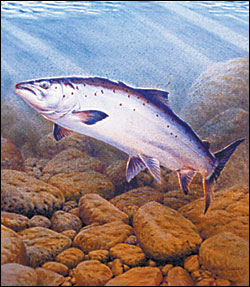Salmon used to be a seasonal treat. That was before Norwegian companies took over Canadian fjords to raise Atlantic salmon in giant pens. Now we can enjoy ruddy-fleshed filets of salmon all year round, at a price competitive with turkey breast, pork loin, and canned tuna.
Last week, a Seattle law firm went to court and sued three of America’s largest supermarket chainsAlbertson’s, Safeway, and Kroger/QFCfor (deep breath here) “unjust enrichment, unlawful, deceptive, and unfair business practices, breach of contract, breach of warranty, and negligent misrepresentation”all for the mere act of selling farmed salmon without a label clearly stating that said fish is salmon-colored only because their flesh is laced with the chemicals astaxanthin and canthaxanthin, administered to the fish (along with the usual hormones and antibiotics fed all battery-raised animals) in their feed.
Scary as astaxanthin and canthaxanthin sound, they are both just variations on good old beta-carotene, the compound that makes carrots carrot-colored, the stuff that people pay good money for in the drugstore for its anti-oxidant properties. Not only thatalmost identical compounds occur in the shells of lobsters, crabs, shrimp, and their microscopic relatives called krill. It’s eating krill that gives natural wild salmon its orangy-red color.
So what have Kroger, Safeway, and co. done to earn the class-action ire of Smith & Lowney, attorneys at law? They have peddled their artificially orange salmon to consumers without a label stating that it is artificially colored and that, without the dyestuffs in question, farmed salmon would be an unappetizing gray, the translucent dirty gray of city slush churned up by traffic.
If a little harmless cosmetic improvement of the product seems slender ground for a megabuck class-action lawsuit, you are absolutely right. But this is the U.S.A. In other parts of the worldScotland, Norway, Canadasalmon farming is being attacked head-on through publicity campaigns, picketing, and consumer boycotts, not because it produces gray fish, but because it is environmentally destructive, hazardous to oceanic (and, indirectly, public) health, and economically unsound.
But in the U.S., it seems to be impossible to accomplish anything worthwhile in the public-policy area without a lawsuit threatening catastrophic financial damage, and the Smith & Lowney lawsuits may finally force retailers to obey laws they’ve been happily flouting for years. Because the law is quite unambiguous. Any coloring matter used in food has to be cleared by the federal Food and Drug Administration, and FDA regs (Title 21 Code of Federal Regulations part 73.35[d][3] & .75[d][4]) require that fish fed astaxanthin and canthaxanthin can legally be sold only when every retail portion thereof is prominently labeled with the words “artificially colored” or “color added” in letters one-quarter of an inch high.
Have you ever seen such a label on supermarket fish? I didn’t think so. Ninety percent or more of the farmed salmon sold in the Northwest comes from British Columbia, and the FDA’s Dr. George Pauli, who helped write the laws in the first place, admits that FDA inspectors are responsible for enforcing its own labeling rules at the border. The problem is that they don’t. There are so few of them, and so many far more pressing inspection chores facing those few, that they just don’t bother. King County health inspector Leonard Winchester has seen his share of 25- and 50-pound boxes of Canadian farmed salmon in supermarket coolers he’s inspected; he’s never seen a box with the label the FDA says ought to be there to get the fish across the border in the first place. “And there’s nothing I can do anyway,” says Winchester, “because there’s no law in King County about labeling salmon as to color.”
MAYBE IN A YEAR or so there will be. Little by little, state agencies like Agriculture and Health are chewing their way through the FDA’s model health code, promulgated in 2001, and expect to have it ready to apply in Washington state by, oh, say, late 2004, 2005 for sure. Trouble is, when it is ready, it’s going to be up to county inspectors like Winchester to enforce, as if they weren’t spread ludicrously thin already. There are plenty of retailers out there who really, honestly, don’t know that there’s any controversy about dyestuffs in salmon; who don’t even know the stuff is dyed.
But you do. Consumers can move mountains that government doesn’t even recognize as there. Look what a few thousand college students have done to adjust the attitude of athletic-wear makers to conditions in their offshore sweatshops. Consumers elsewhere are already putting the squeeze on the antibiotic-abusing, water-polluting, ecosystem-degrading farmed-salmon industry by refusing to buy its products and giving those who sell them hell for doing so. A class-action lawsuit? Swell, if it gets the public’s attention, but the courts can’t do anything if the people who eat the stuff don’t care.








